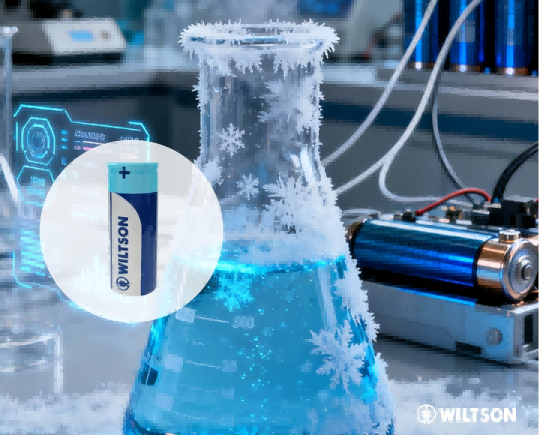Low Temperature Electrolyte Design | Improving Lithium Battery Performance in Cold Weather

(The Physical Problems to Solve)
Low-temperature failure mainly comes from three key issues:
- Higher electrolyte viscosity, which reduces ionic conductivity.
- Slower desolvation kinetics of solvent/ion clusters at the electrode interface.
- Increased SEI/CEI resistance or brittleness, leading to higher charge-transfer impedance.
So, a well-designed low-temperature electrolyte must:
- Lower viscosity while keeping ionic conductivity high.
- Optimize Li⁺ solvation so ions can still desolvate efficiently and form a stable, low-resistance SEI layer even in extreme cold.
- Maintain safety and high-voltage compatibility, without causing solvent co-intercalation or cathode oxidation issues.
Research and experimental data strongly support these principles — especially the role of FEC, which reduces impedance at low temperatures. The best salt concentration and composition often differ from those that perform best at room temperature.
(Source: U.S. Department of Energy, Energy.gov)
Common Strategies
(Mechanisms, Pros, and Cons)
EC helps build stable SEI layers, but it’s solid and highly viscous, which hurts low-temperature performance. Reducing EC (or going EC-lean) significantly improves ion transport, but SEI quality must be compensated with additives like FEC or VC. Studies by DOE/PNNL show that lower EC ratios and adjusted salt concentrations reduce low-temperature impedance.
(Source: U.S. Department of Energy)
These solvents lower viscosity and boost conductivity and rate performance at low temperatures. However, ethers (like DME) oxidize easily, making them unsuitable for high-voltage cathodes unless paired with HCE/LHCE systems or cathode-protection coatings.
(Source: Academic Research Platforms)
LiFSI or LiTFSI often outperform LiPF₆ in low-temperature conductivity and SEI formation, with lower crystallization tendencies. But LiFSI can corrode aluminum, so corrosion inhibitors are needed.
The optimal concentration at low temperature is typically lower than the standard 1.0 M — research suggests around 0.6–0.9 M provides the best impedance balance.
(Source: Boise State University)
HCE/LHCE systems alter solvation structures, promoting LiF-rich SEI formation that enhances low-temp cycling stability. LHCEs retain the benefits of HCE while lowering viscosity through low-polarity diluents.
This design provides excellent SEI quality and Li plating/stripping stability, though it requires careful control to prevent temperature-dependent phase separation.
(Source: Chemistry Europe)
Three Practical Low-Temperature Formulations
(Recommended as initial test batches for lab or pilot-scale trials)
⚠️ These are engineering starting points, not final recipes.
Actual electrode chemistry, C-rates, and operating temperatures will influence the results. Always verify with EIS, cycling, and corrosion tests.
Formula A — Balanced Low-Temperature Performance
(For graphite anodes and moderate-voltage cathodes)
- Solvents (v/v): EC : EMC : DMC = 10 : 50 : 40
- Salt: 0.8 M LiPF₆ (or 0.8 M LiPF₆ + 0.05 M LiDFOB)
- Additives: 5 wt% FEC + 0.5 wt% VC
Higher ionic conductivity and better low-temp rate capability than LP30/57. FEC maintains SEI stability down to -30°C to -40°C. Slightly reduced high-temp stability — thermal tests required.
(Source: U.S. Department of Energy)
Formula B — Extreme Cold Applications
(For sub-zero or polar conditions)
- Solvents (v/v): DME : DMC = 40 : 60 (EC-free or minimal EC)
- Salt: 0.7–1.0 M LiFSI
- Additives: 8 wt% FEC (or 5 wt% FEC + 2 wt% LiDFOB)
Maintains solid capacity and discharge rate at -40°C. Best for aerospace, ground operations, or polar missions. Limited oxidation stability — unsuitable for >4.3 V cathodes. Requires aluminum corrosion control.
(Source: Boise State University)
Formula C — LHCE-Type System
(For low temperature + higher-voltage compatibility)
- Base: High-concentration LiFSI in DMC or EMC
- Diluent: Low-polarity fluorinated solvents (e.g., TFEO or HFE)
- Example (molar ratio): LiFSI : DME : TFEO = 1.2 : 1 : 2
- Additive: 3–5 wt% FEC
Forms stable, LiF-rich SEI with controllable viscosity and good cold performance. Useful when low-temperature operation and high-voltage tolerance are both required. More complex and costly — diluent sourcing must be evaluated.
(Source: Boise State University)
Key Validation and Characterization Tests
To confirm low-temperature readiness, perform these minimum tests:
- Conductivity vs. Temperature (-60°C → +25°C)
- EIS (Half & Full Cells) to separate charge-transfer and interface impedance
- Low-Temperature Charge/Discharge Cycling across C-rates
- Surface Analysis (XPS / TOF-SIMS / SEM) for SEI composition and morphology
- Aluminum Corrosion & Electrolyte Stability Tests (for LiFSI or high-salt systems)
- Thermal Safety Tests (DSC / Flash Point) for flammability and thermal limits
As multiple reviews emphasize, iterative testing and SEI analysis should guide electrolyte formulation development.
(Source: Academic Research Platforms)
Practical Engineering Recommendations
- ✅ If you need compatibility with standard cathodes (>4.2 V):
Go with Formula A (EC-lean + FEC + slightly lower salt) as your first industrial test.
(Source: U.S. Department of Energy) - ✅ If targeting ultra-low temperatures (<−40°C):
Try Formula B (ether + LiFSI) or Formula C (LHCE) — you’ll get extreme low-temp performance but need extra cathode protection.
(Source: Boise State University) - ✅ Quick Wins for Pilot Testing:
Start with your current electrolyte, but run a matrix test with FEC (3–8 wt%) and reduced salt (0.8 → 0.6 M). DOE and PNNL data show this approach quickly reduces impedance and restores low-temp capacity.
(Source: U.S. Department of Energy)

